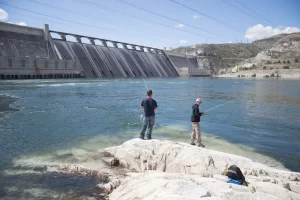Urban angling has gained significant popularity in recent years, offering city dwellers an escape into nature without leaving the city limits. One of the best and most accessible forms of city fishing is dam fishing. With dams often located near urban areas, they create excellent fishing opportunities due to the unique ecosystems they foster. This guide will help you navigate dam fishing in the city, offering tips, techniques, and popular species to target.
1. Why Dams Are Ideal for Urban Fishing
Dams create unique environments by altering water flow and creating reservoirs, which in turn provide excellent habitats for a variety of fish species. The concentrated water flow near dams also attracts fish, making these spots prime locations for angling. For city dwellers, dams located within or near urban areas offer an easy escape for a quick fishing session without having to venture far from home.
Urban dams often boast a variety of fish species, including bass, catfish, walleye, carp, and even trout in some regions. These species thrive in the mix of fast-moving and slow-moving water created by the dam, providing diverse fishing opportunities year-round.
2. Choosing the Right Dam for Fishing
Not all dams are created equal, and some are more accessible and productive for fishing than others. Look for dams that allow public access and have a reputation for being safe to fish near. Many city parks, reservoirs, and urban waterways have designated fishing areas near dams that are well-maintained and frequently stocked.
Research local regulations before heading out, as some dams may have restricted access or special fishing rules. Additionally, always be mindful of the potential dangers of fishing near a dam, such as sudden water releases or fast currents.
3. Best Times for Dam Fishing
The time of day and season play a big role in your success when dam fishing. Early morning and late evening are often the best times to fish, as the water temperatures are cooler, and fish tend to be more active. During the summer, fish may congregate in the cooler, oxygen-rich water near the dam, while in the winter, they may move to deeper waters.
Spring and fall are typically the most productive seasons for dam fishing, as fish are more likely to be feeding aggressively during these transitional periods.

4. Techniques for Success at the Dam
- Casting into Eddies: Dams create natural eddies where the current slows down, and these areas tend to collect baitfish. Predatory fish like bass and walleye often wait in these areas, making them prime spots for casting.
- Drifting Baits: Letting live bait or lures drift naturally in the current near the dam can attract fish. Catfish and carp, in particular, are drawn to food that is carried by the water.
- Vertical Jigging: For areas with deep water near the dam, vertical jigging can be an effective method, especially for targeting species like walleye and crappie.
5. Popular Species to Target
Dam fishing offers opportunities to catch a variety of species depending on the location and water conditions. Some of the most common species found near urban dams include:
- Largemouth and Smallmouth Bass: Bass are often found near structures and current breaks created by dams.
- Catfish: The deep waters near dams are ideal for catfish, which are often drawn to the areas where food collects.
- Walleye: Walleye tend to gather in fast-moving water and eddies created by dams, especially during spring and fall.
- Carp: These hardy fish thrive in dam environments and offer a fun challenge for anglers.
6. Gear Recommendations for Dam Fishing
When fishing at a dam, bring gear that suits both the environment and the species you’re targeting. Medium to heavy rods with strong line are recommended, as you’ll need to handle both strong fish and the strong currents created by the dam. For bait, consider using live worms, minnows, or artificial lures that mimic the natural prey in the area.
7. Safety Tips
Fishing near dams can be dangerous due to unpredictable water releases and fast currents. Always stay aware of your surroundings, and avoid standing too close to the water’s edge. Wearing a life jacket is also recommended, especially if you’re fishing in high-risk areas or near swift-moving water.
Dam fishing in the city provides a unique opportunity for urban anglers to experience excellent fishing without leaving the convenience of their surroundings. By selecting the right dam, utilizing effective techniques, and staying safe, anglers can enjoy a productive and exciting day of fishing.
Image: gcdvisitor





